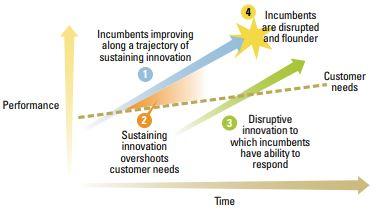A range of management theories makes a significant impact on market development and incumbents, such as Clayton Christensen’s disruptive innovation. Elaborated in the middle of the 1990s in response to the rapidly growing change in various fields, the theory explains why well-managed companies fail. In his book called The Innovator’s Dilemma: When New Technologies Cause Great Firms to Fail, Christensen (2016) describes 77 companies with disruptive innovations, including Sony, Linux, Cisco, Southwest Airlines, Toyota, and so on. As defined by the author of the theory, disruptive innovation shapes a new network of values on the market that displaces the existing products. The key features of the mentioned theory are simplicity and convenience, consisting of off-the-shelf components combined into product architecture. Such an approach offers less of what customers want in current markets and, therefore, giant companies often cannot implement them. In other words, disruptive innovation presents a different set of attributes that are praised only in emerging markets and unimportant for the mainstream.
Speaking of the influence of disruptive innovations on incumbents, it is critical to point out that Christensen and Raynor (2003) discuss four important areas. In particular, incumbents tend to enhance along with the trajectory of innovation, focusing on sustaining and growing the contemporary level of success. While the pace of supporting innovation overshoots the demands of customers, incumbents often fail to properly combat disruption due to a paralyzing effect of the latter (Christensen & Raynor 2003). In other words, even when managers have some tools to address disruption, they miss the opportunity to prevent potential threats to a company (see Figure 1 for details).

The discussion of the theory conducted by King and Baatartogtokh (2015) shows that not all of the above impacts may be noted in cases described by Christensen (2016). For example, 31 percent of specialists interviewed during the study reported that they are skeptical about the actuality of improvement trajectory for incumbents, noting that bazaars, for instance, existed before the emergence of eBay. 78 percent of respondents stated that incumbent companies are unlikely to anticipate customers’ demands (King & Baatartogtokh 2015). These findings illustrate that the disruptive innovation theory is much more complex than it may seem and, therefore, further research is needed to identify its role and impacts with regard to managers.
The effect of disruptive innovation on the market may vary depending on a certain country and specific factors. For example, Wan, Williamson, and Yin (2015) state that the Chinese market provides research and development (R&D) opportunities for disruptive innovations, and the latter also stimulates the former. Guttentag (2015) mentions such a consequence as the emergence of an informal tourism sector that appeared as a result of Airbnb’s business model of providing rentals through the Internet. In general, the main impact results in the fact that old products become uncompetitive since the parameters on the basis of which competition had previously been held lose their value. Due to the factor that disruptive innovations are made by start-ups, not by market-leading companies, the market is likely to experience the influx of new companies and products that cause the market structure change.
To address threats, effective companies and managers should apply several strategies, among which the most important is referring to the introduction of disruptive innovation to new organizations. Instead of combining the existing and innovative technologies, it is better to separate them and create new responsible departments and organizations (Christensen & Raynor 2003). It is also advisable to turn disruptive technologies into commercial products, which will help them in learning useful lessons and adjusting the course of business if required.
Reference List
Christensen, C & Raynor, M 2003, The innovator’s solution: creating and sustaining successful growth, Harvard Business Review Press, Boston.
Christensen, C 2016, The innovator’s dilemma: when new technologies cause great firms to fail, Harvard Business Review Press, Boston.
Guttentag, D 2015, ‘Airbnb: disruptive innovation and the rise of an informal tourism accommodation sector’, Current Issues in Tourism, vol. 18, no. 12, pp. 1192-1217.
King, AA & Baatartogtokh, B 2015, ‘How useful is the theory of disruptive innovation?’, MIT Sloan Management Review, vol. 57, no. 1, pp. 77-90.
Wan, F, Williamson, PJ & Yin, E 2015, ‘Antecedents and implications of disruptive innovation: evidence from China’, Technovation, vol. 39-40, pp. 94-104.